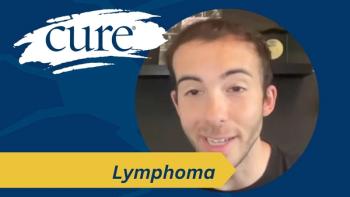
Considerations in the Diagnosis of Follicular Lymphoma
Transcript:
Parameswaran Venugopal, M.D.: Welcome to the section of CURE Expert ConnectionsÒ. This is a program that is focused on improving and understanding the lives of patients with follicular lymphoma. My name is Dr. Venugopal. I’m from the Rush University Medical Center. I am a professor of medicine, and I direct the section of hematology. Today I’m joined by Jennifer Garson, physician assistant, from the section of hematology, as well as one of our patients, Mr. Gerald Koch, who has follicular lymphoma, who is going to share with us his story of the disease and what he went through and how he’s doing.
And thank you, Jennifer, for joining me.
Jennifer L. Garson, PA-C: You’re welcome.
Parameswaran Venugopal, M.D.: So maybe we can talk about non-Hodgkin lymphoma in general. As you know, it is one of the more common cancers. And follicular lymphoma is the low-grade subtype of non-Hodgkin lymphoma, which is the most common low-grade B-cell lymphoma and also the second most common non-Hodgkin lymphoma.
I think in 2018 about 75,000 new patients were diagnosed in the United States. And about 20 percent to 30 percent of these patients had follicular lymphoma. And follicular lymphomas are diseases that can go for a long time, sometimes even without treatment. That’s why if you look at the prevalence—that is, the number of patients alive, the total non-Hodgkin lymphoma — it comes to about 700,000 patients at any time, at least based on the 2015 statistics.
Maybe let’s talk about the risk factors that are involved in follicular lymphoma. There are many factors starting with, for example, age.
Jennifer L. Garson, PA-C: So generally our patients do present older in age. The median age of a follicular lymphoma diagnosis is anywhere from early 60s to mid-70s, with our median patients being in their mid-60s. We generally do see a male predominance in non-Hodgkin follicular lymphomas.
Parameswaran Venugopal, M.D.: Yes.
Jennifer L. Garson, PA-C: So we do see older patients, usually males. As far as family risk, there’s really not a hereditary link, but I think more and more, we’re finding genetic variance within families that are associated with these non-Hodgkin lymphomas, especially the low-grade lymphomas.
Parameswaran Venugopal, M.D.: I agree completely, yeah. So it is not like in breast cancer, where you can define the risk of a patient getting breast cancer based on family history. But in non-Hodgkin lymphoma we don’t have a pattern like that. Although we do see in some families that there’s an increased number of incidents. But there is no genetic pathway that is yet established. Other risk factors—including environmental factors, exposure, prolonged exposure to toxins and even fertilizers— have been mentioned, but nothing has been scientifically proven.
In terms of the risk stratification of the patient, in the clinic usually we use a certain scoring system. One is called FLIPI, or F-L-I-P-I. It is a prognostication system in which we take several factors, like the patient’s age, the number of lymph nodes and the size of the lymph nodes, and put them together, and we can classify them into low and high risk. And based on that we can make decisions on treatment choice and can give the patient an approximate prognosis in terms of what is the likely survival.
So these are things that help us in everyday practice in the clinic, helping patients to understand their disease and understand what is coming up in their life with respect to the disease.
Jennifer L. Garson, PA-C: And I think one of the hardest things from a provider’s standpoint with low-grade lymphomas—and you may agree or disagree, I don’t know—is that there’s such diversity, not just in how our patients present but in our patients in general, as far as where they are in their lives, what their quality of life is at the point that they present with us, and their comorbidities, which can add to the challenges.
Parameswaran Venugopal, M.D.: You’re absolutely right. Particularly comorbidity can be a major factor in deciding what is the appropriate treatment. And that leads us to some of the new developments we have in this area, whereas unlike in the past we only had chemotherapy, which, as you know, causes significant adverse effects. And therefore, the option of chemotherapy is restricted to people who are otherwise healthy and younger. Whereas now we have options other than chemotherapy. The new agents, biological agents, which we can apply to older patients and patients with comorbidity.
Transcript Edited for Clarity




